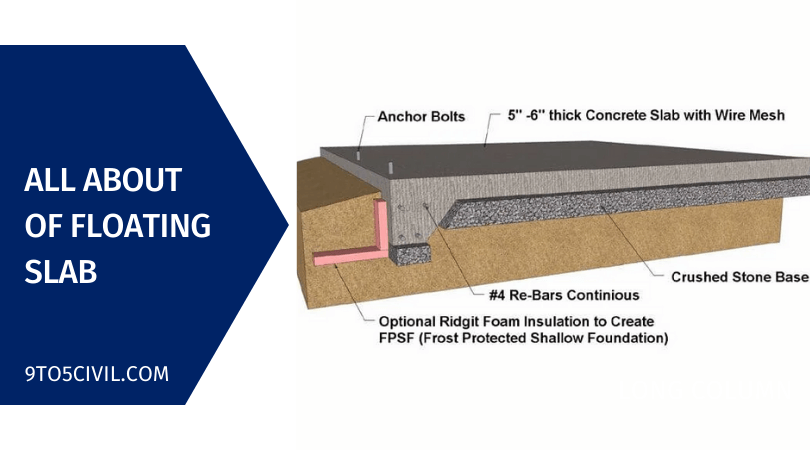
What Is a Floating Slab?
Floating slab foundations are used in any building where there is a need for low load-bearing for the structure. The floating slab is a type of concrete slab. This type of slab is placed on the ground without any anchoring. A floating slab foundation is a shallow foundation.
Purpose of Floating Slab Foundation
Where there is no need for a deep foundation for a small structure. A floating slab foundation is used there. This type of slab is made over water with no connection between them.
The main application of floating slabs can be used as a foundation for small types of structures such as manufacturing workshops, sheds, garages, and additional rooms in the house.
Floating Slab Construction
Site Preparation
1. Site Excavation
2. Reinforcement for Slab
After the first process is completed Then steel binding is done according to structural design.
In reinforcement, lapping should not come in one place. reinforcement lapping should be done according to an alternate method. Must have strength as per reinforcement Is code.
3. Shuttering Work for Floating Slab
smooth surface, Proper alignment, and good quality work can be provided using formwork in the floating slab.
Tight formwork should be laid in such a way that slary does not come out of the formwork during concreting.
The cover block should be fixed after the shuttering work is completed especially tighten the support so that the formwork does not open during concreting.
Proper measurement should be fixed, and adequate support should be given to the shuttering formwork.
4. Concreting
For Floating slab concrete is made by mixing in a mixer machine at the site or ready mix concrete can also be used. If the quantity of concrete is high, ready-mix concrete can be used.
If concrete is formed on the site, care must be taken to ensure that the material is mixed in a proper mixer machine. proper mixing material gives strength high.
Adequate compaction of concrete should be done during concreting of the floating slab.
The quality of concrete is maintained with adequate compaction and proper guidance the top layer is finished after concreting is finished.
Its side is opened 24 hours after the concrete is done.
5. Curing
It should be cured for seven days. Water is sprinkled for curing.
Curing plays an important role in affecting strength.
Advantage of Floating Slab
- Distribution of load on a floating slab foundation is a technique for transferring over a large area.
- Floating slabs can prevent moisture from entering the home floor. The work of separating between the superstructure and the ground is done by the floating slab. In addition, the floating slab protects from factors such as water and frost.
- The area of the earth that is most likely to be settled. And where humidity is high, floating slabs are best suited
- In areas where construction is to be carried out with low load carrying capacity and where investing money in land treatment is in vain, it is prudent to do a floating slab.
- Floating slab construction are a good solution when it comes to redeveloping homes. Floating slab In such a situation building extension can be done without affecting the old foundation. This type of foundation will not interfere with the structure.
- There is no need to deepen the foundation where sheds are to be built. Instead, floating slab remains advantageous.
- floating slab foundation merges with the earth’s crust and increases in strength.
Disadvantage of Floating Slab
- There is no space for a sewage line from this type of foundation. So a trench has to be made for it during the floating slab.
- It cannot be used for overloaded bearing structures.
- Repairing a floating slab is expensive.
Like this post? Share it with your friends!
Suggested Read –
- Seasoning of Timber | Rat Trap Bond | Space Frame | Building Skeleton | Bond Breakers
- Post Tension Slab | Concrete Topping | Pier and Beam Foundation | Salt Finish Concrete
- Stained Concrete Floors Pros and Cons | How To Stamp Existing Concrete?
- Concrete Sealer for Garage | Sandblasted Finish Concrete | Spalling Concrete
- Concrete Cistern Tank | How to Build a Pier Foundation? | Recycled Concrete Aggregate
Floating Slab
A floating slab is a reinforcement concrete slab used for a shallow foundation. The floating slab is a type of concrete slab. This type of slab is placed on the ground without any anchoring.
Floating Concrete Slab
A floating slab is a reinforcement concrete slab used for a shallow foundation. The floating slab is a type of concrete slab. This type of slab is placed on the ground without any anchoring.
Floating Slab Foundation
The floating slab is a type of concrete slab. This type of slab is placed on the ground without any anchoring.
Floating Concrete Floor
Floating Concrete Slab is used as the foundation for a variety of structures, including sheds, car garages, additions, cottages, and much more. The slabs are reinforced around the perimeter, but there are no frost footings. They are called “floating” because they are allowed to move above the frost line as a monolithic unit.
 Skip to content
Skip to content 
